Protect Landscape Ash Trees from Emerald Ash Borers
If you have one or more “high-value” ash trees in your lawn or landscape—trees that you really do not want to lose, trees on which you are willing to spend around $50 to $100 annually to keep—then you may want to learn how to protect them from the emerald ash borer, Agrilus planipennis. As of February 2019, the emerald ash borer (EAB) has not yet been detected in Mississippi, but it is present in all neighboring states and could appear
here at any time. In fact, Mississippi and Florida are the only states east of the Mississippi River where EAB is not yet established. The emerald ash borer is a serious pest of ash trees that has already killed hundreds of millions of ash trees in the eastern United States. Effective treatments are available for protecting high-value landscape trees from emerald ash borers, but these treatments must be applied preventively in order to protect trees before they become seriously infested and damaged.
Emerald ash borers were first detected in the U.S. in 2002 near Detroit, Michigan, likely arriving from Asia in crates or pallets made from infested ash lumber. In the past 15 years, the pest has spread to 31 states, as well as portions of Canada. It attacks all species of ash but, fortunately, does not attack most other hardwood species (does attack olive trees and white fringe trees). Tree death is caused by the larvae tunneling in the inner bark and girdling the tree; there is no associated disease that is transmitted by EAB. Although EAB does spread under its own power, most adult beetles fly fewer than 2–3 miles from the tree from which they emerged, with a smaller portion of the population flying as far as 15 miles or so. But emerald ash borers can quickly and easily travel long distances in infested ash firewood or lumber, and the rapid spread of EAB is largely the result of human-assisted movement. It happens as easily as: “Honey, when we go camping down south this weekend, let’s take some wood from that ash tree we just had taken down so we can have a camp fire.”
Description
Adults are small, peg-shaped, metallic-green beetles. The larvae, which live beneath the outer bark, have slender, white, segmented bodies, with many of the segments appearing bell-shaped. Infestations are usually first detected by observation of damage symptoms, including dieback of limbs in the crown of the tree; splitting and peeling of bark; presence of small, D-shaped emergence holes (about one-eighth inch diameter); new growth sprouting from the lower trunks of the tree; and woodpecker feeding. There is only one generation per year. Adults lay eggs in bark crevices in the spring, and larvae feed beneath the outer bark through the summer and fall, overwinter, and emerge as adults the following year.

Damage
Emerald ash borers primarily attack ash trees, but they have also been reported to attack white fringe trees and olive trees here in the U.S. Adult beetles feed on leaves but do not cause significant damage. The serious damage is caused by the larvae, which bore in the inner bark, girdling tree limbs and trunks. Damage usually progresses down from the crown of the tree, and trees are usually killed after 3–5 years of infestation. Mortality of untreated ash trees is around 99 percent. Experience in other states indicates that trees that have lost more than 25–50 percent of their canopy due to crown dieback usually cannot be saved. This is why it is important to begin preventively treating trees you really want to protect when EAB is detected within 15–30 miles of your location. The objective is to protect the trees before the beetles arrive.
See MSU Extension Publication 2896 Signs and Symptoms of Emerald Ash Borer for more information on damage and symptoms.
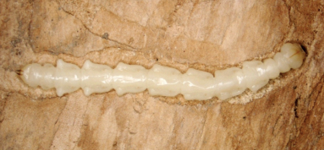
Management
Preventing initial introduction is the first line of defense. Avoid transporting firewood or ash logs into the state. Report suspected infestations of Mississippi ash trees to your local county MSU Extension office or the Mississippi Department of Agriculture. Trees that become infested with emerald ash borers, and that will not be treated, should be immediately cut and destroyed in order to prevent emergence and spread of adult beetles. Do not allow infested wood to be transported away from the site. Burning is the surest means of destroying all EAB in infested wood, but chipping to fragments less than 1 inch can also work, as long as the chips are not transported out of the infested area (because there is potential for some adults to survive the chipping process). Avoid planting ash trees in new landscape plantings; choose alternative species that are not susceptible to emerald ash borers.
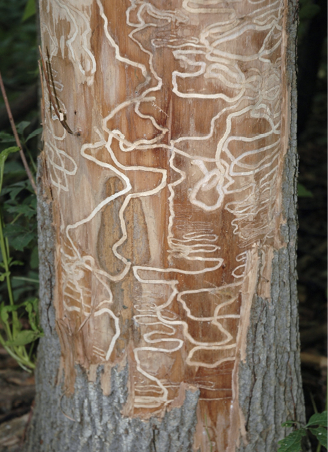
Preventive Control
Experiences in other states have shown that, once EAB arrives in an area, trees that are not properly protected will be killed. This means homeowners and landscape managers must proactively decide whether or not there are any ash trees in the landscape that they want to protect. Obviously, many factors affect this decision, including the location, size, and beauty of individual trees and their overall value and contribution to the landscape, as well as cost of removing trees that are killed. Tree removal is expensive, and, in some cases, the cost of having a tree removed can exceed the cost of the repeated treatments needed to protect it.
To protect high-value landscape ash trees, be alert for reports of the presence of emerald ash borer infestations within 15–30 miles of your location and begin preventive insecticide treatments promptly. Depending on choice of treatment, plan on treating yearly (or every second year, only for emamectin benzoate treatments) for as long as you want to protect the trees. Optimum treatment timing depends on weather, choice of insecticide, and method of application but ranges from early to late spring (around March 1 through mid-April), with slow-acting, soil-applied treatments needing to be applied earlier than trunk-injection treatments. The objective is to have the insecticide in the tree by the time adults emerge and begin feeding on leaves and laying eggs. However, treatments can and should be applied at other times (late spring through fall) if you learn of nearby infestations of emerald ash borers. In such cases, it is best to use treatments such as trunk injections or basal trunk sprays, which are faster acting than soil-applied treatments.
Systemic insecticides that move through the tree to kill adult beetles feeding on leaves in the spring and young larvae feeding in the inner bark are the most effective treatments for emerald ash borers. Such treatments are applied in one of three ways: as soil drenches or soil injections around the base of the tree, as injections into the trunk of the tree, or as systemic basal trunk sprays. Soil drench is the treatment method that is most appropriate for homeowners. Trunk injections and trunk sprays are best applied by licensed commercial applicators, and commercial applicators can also use treatments that are applied as soil drenches or soil injections.
White fringe trees can be preventively protected using the same treatments that are used on ash trees. Based on preliminary reports, Chinese fringe tree is less susceptible to EAB attack and damage, making it a preferred alternative for new plantings.
Soil-Applied Treatments
Soil-applied insecticides available for use by homeowners, as well as commercial applicators, include imidacloprid and dinotefuran. These treatments must be reapplied annually in order to provide effective protection. Soil-applied treatments are somewhat less effective and consistent than some of the more effective trunk-injection treatments, especially on larger trees. If trees are larger than 15 inches diameter at breast height (47-inch circumference), it is best to have them professionally treated with an effective trunk-injection treatment.
Trunk-Injection Treatments
Treatments that can be applied as trunk injections by licensed commercial applicators include imidacloprid or emamectin benzoate. Although more costly than other treatments, emamectin benzoate (Tree-age) is one of the more effective treatments, and a single application will provide control for 2–3 consecutive years. Thus, trees treated with emamectin benzoate need to be re-treated only every second year.
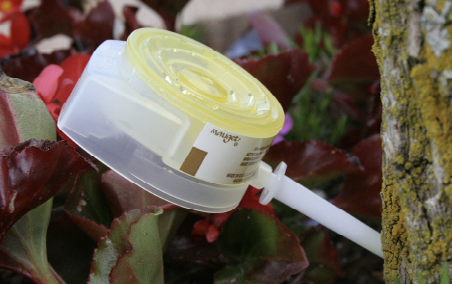
Systemic Basal Trunk Sprays
Some products containing dinotefuran (Safari 20 SG and Zylam) can also be applied by commercial applicators as systemic basal trunk sprays. These are applied as concentrated sprays to the lower 5 feet of the trunk, where the insecticide penetrates the bark and is translocated through the tree’s vascular system. Basal trunk sprays must be repeated annually.
Emerald ash borer treatments for homeowner application*
|
Active Ingredient |
Brand Name |
Application Rate* |
Comments |
|
imidacloprid, 2.94% |
BioAdvanced Tree & Shrub Insect Control |
0.5 fl oz per inch of trunk circumference |
Apply in early to mid-spring. Must be reapplied every year to maintain protection. |
|
imidacloprid, 1.47% (Also many generic formulations) |
Bonide Annual Tree & Shrub Insect Control |
1 fl oz per inch of trunk circumference (measure at breast height, 4.5 ft) |
Apply in early to mid-spring. Must be reapplied every year to maintain protection. |
*These are common examples, but other products, including generic formulations of listed active ingredients, may also be labeled for this use.
Soil-applied systemic EAB insecticides (applied as soil drench or soil injection) for commercial application*
|
Active Ingredient |
Brand Name |
Restricted Use? |
Application Rate |
Comment |
|
dinotefuran, 20%v |
Safari 20 SG |
No |
7–12 grams (3–5 teaspoons) per inch of trunk diameter at breast height |
Apply after trees have leafed out in mid- to late spring. Must be reapplied every year. |
|
dinotefuran, 10% |
Zylam Liquid Systemic Insecticide |
No |
0.4–0.8 fl oz per inch of trunk diameter at breast height |
Apply after trees have leafed out in mid- to late spring. Must be reapplied every year. |
|
imidacloprid, 21.4% (Also many generic formulations) |
Merit 2F, Xytect 2F |
No |
0.2 fl oz per inch of trunk diameter at breast height |
Apply in early to mid-spring. Must be reapplied every year to maintain protection. |
*These are common examples, but other products, including generic formulations of listed active ingredients, may also be labeled for this use.
Systemic basal trunk spray EAB treatments for commercial application*
|
Active Ingredient |
Brand Name |
Restricted Use? |
Application Rate |
Comment |
|
dinotefuran, 20% |
Safari 20 SG |
No |
Mix per label directions. |
Apply after trees have leafed out in mid- to late spring. Must be reapplied every year. Uniformly spray lower 5 feet of trunk, using low pressure spray (10–20 PSI). |
|
dinotefuran, 10% |
Zylam |
No |
Mix per label directions. Include required surfactant. |
Apply after trees have leafed out in mid- to late spring. Must be reapplied every year. Uniformly spray lower 5 feet of trunk, using low pressure spray (10–20 PSI). |
*These are common examples, but other products, including generic formulations of listed active ingredients, may also be labeled for this use.
Systemic trunk-injection EAB treatments for commercial application*
|
Active Ingredient |
Brand Name |
Restricted Use? |
Application Rate |
Comment |
|
emamectin benzoate, 4% |
Tree-age |
Yes |
Rate depends on trunk diameter at breast height. See label. |
Apply after trees have leafed out in mid- to late spring. Provides 2+ years of control. Must be reapplied every other year. |
|
imidacloprid, 10% |
Imicide, Imicide Hp |
No |
Rate depends on trunk diameter at breast height. See label. |
Apply after trees have leafed out in mid- to late spring. Must be reapplied every year. |
*These are common examples, but other products, including generic formulations of listed active ingredients, may also be labeled for this use.
How to Use Soil-Applied Systemic Insecticide Drenches
- Begin applying annual preventive treatments when EAB is detected within 15–30 miles.
- Early to mid-spring is the optimum time for applying soil-applied drenches.
- Count and measure trees to determine how much product is needed.
- For homeowners treating large numbers of trees, it may be easier and cheaper to purchase one of the commercial imidacloprid or dinotefuran products. Most of these are not restricted-use products and do not require a special license to purchase.
- Note whether rate is based on inches of circumference (distance around trunk) or diameter (distance through trunk). See product label. Also note the use rate.
- Measure tree circumference at breast height—4.5 feet aboveground (divide inches circumference by 3 to obtain diameter).
- Calculate the amount of product required based on individual tree measurement, and use the rate specified on the label. For example, if the rate is 1 fl oz per inch of distance around the tree and the tree is 32 inches in circumference, it would take 32 fl oz of product to treat the tree.
- Dilute the required amount of product in 2–3 gallons of water.
- Rake mulch and leaves away from the base of the tree.
- Pour drench uniformly around the base of the tree, within 1 foot of the trunk.
- Re-treat trees annually for as long as you wish to maintain protection.
- For trees greater than 15 inches diameter (37-inch circumference), trunk injection, applied by a professional applicator, will provide improved protection and control.
How to Know if Emerald Ash Borers Are Near You
Check with your local county MSU Extension office regularly to monitor the spread of EAB and to determine when infestations are near enough to your location to trigger the application of protective insecticide treatments. Begin applying preventive treatments when EAB are reported within 15–30 miles away. Do not wait until trees are heavily damaged to begin treatment; by then it will be too late to save the tree.
Report Possible Detections of Emerald Ash Borers
The emerald ash borer is well-established in southern Arkansas and northern Louisiana and is slowly spreading toward northwestern Mississippi. However, because EAB is easily transported in firewood and other ash lumber, EAB could initially occur anywhere in the state where ash trees are. If you observe ash trees that are exhibiting symptoms of possible EAB infestation—crown die-back; dead or dying limbs; dead or dying trees; new growth sprouting from the lower trunk; splitting or peeling bark; woodpecker feeding; or small, D-shaped emergence holes in the bark—please report the location of suspect trees to your local county MSU Extension office and/or the Mississippi Department of Agriculture. Be aware, however, that there are some native ash pests that can cause symptoms that are similar to those caused by EAB.
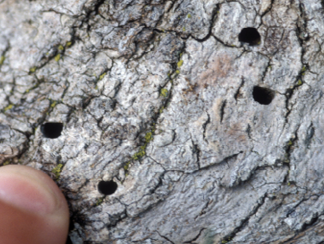
Other Native Wood-Boring Ash Pests in Mississippi
There are a few native wood-boring insects that attack ash trees. These include the ash/lilac borer and the redbanded ash borer.
The ash borer, also known as lilac borer, Podesia syrngiae, is a wasp-like, day-flying moth that lays its eggs on the bark of ash trees. The hatching caterpillars chew through the bark and feed into the sapwood of the trunk and larger branches. Feeding by ash borer caterpillars results in sunken, distorted lesions in the bark of limbs and trunks. Heavy and/or repeated infestations can cause crown die-back, similar to that caused by emerald ash borer, and can occasionally kill trees. One of the most distinguishing signs of ash borer infestation is the presence of empty pupal cases protruding through the bark that were left behind by emerging moths. Emergence holes are also larger than those of EAB (approximately one-fourth inch in diameter) and have an irregularly round shape. Heavy infestations are most common in trees growing in stressful situations, such as in or around parking lots. Some other species of moths in this genus also attack ash trees. With the exception of trunk injections of emamectin benzoate, treatments used to control emerald ash borers are not recommended for ash/lilac borers. Ash/lilac borers can also be controlled with trunk sprays of long-residual insecticides, such as bifenthrin or chlorantraniliprole, timed to control hatching caterpillars as they are boring into the bark.
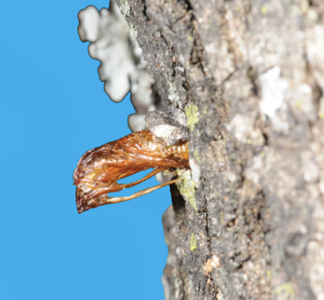
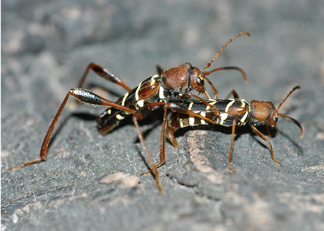
The redheaded ash borer, Neoclytus acuminatus, is a longhorn beetle that attacks stressed or dying ash trees. They are sometimes seen laying eggs on trees that are dying, but they are rarely the cause of tree death. Adult beetles are attracted by odors produced by stressed trees and deposit their eggs on the bark. The resulting larvae bore into the tree, producing galleries deep in the softwood, unlike emerald ash borers, which produce galleries just beneath the outer bark. Emerging adults leave round to oval exit holes in the bark that are approximately one-fourth inch in diameter. Some other beetles in this genus also attack ash trees. Control is not usually recommended for these beetles because they only attack trees that are already dying or in serious decline due to other causes.
What About Trees that Can’t Be Treated?
“We have dozens of ash trees on our property, and we probably can’t afford to treat them all. What will happen to the trees we don’t treat?” They will probably all be killed when the emerald ash borer reaches your area. However, there is no way to predict when this will happen, and it could be many years away. Trees that are killed will either have to be removed or allowed to decay in place, but there is no need to rush into cutting down large, healthy ash trees unless there is some good reason to do so.
One example of such a reason might be a landscape that has excessive numbers of ash trees. In this case, you might decide to go ahead and remove some of these and replace them with other trees in order to create greater species diversity. Another example might be a landscape that contains numerous ash trees. You might not want to risk having huge tree-removal costs concentrated in a 1- or 2-year timeframe, so you may decide to go ahead and start removing a few trees each year in order to spread out the costs. In some situations, owners of commercial timberlands with relatively high populations of ash may decide to proactively harvest salable-sized ash trees, rather than waiting until these trees are killed by EAB.
References
Emerald Ash Borer Information Network. (n.d.). www.emeraldashborer.info.
Flower, C. E., Dalton, J. E., Knight, K. S., Brikha, M., & Gonzalez-Meler, M. A. (2015). To treat or not to treat: Diminishing effectiveness of emamectin benzoate tree injections in ash trees heavily infested by emerald ash borer. Urban Forestry & Urban Greening, 14:790–795.
Herms, D. A., McCullough, D. G., Smitley, D. R., Sadof, C. S., & Cranshaw, W. (2014). Insecticide options for protecting ash trees from emerald ash borer. North Central IPM Center Bulletin. 2nd Edition. 16pp.
McCullough, D. G., Poland, T. M., Anulewicz, A. C., Lewis, P., & Cappaert, D. (2011). Evaluation of Agrilus planipennis (Coleoptera:Buprestidae) control provided by emamectin benzoate and two neonicotinoid insecticides, one and two seasons after treatment. Journal of Economic Entomology, 104:1599–1612.
Willis, J., Self, B., & Layton, B. (2015). Signs and Symptoms of Emerald Ash Borer, Mississippi State University Extension Extension Publication 2896, 4pp.
The information given here is for educational purposes only. References to commercial products, trade names, or suppliers are made with the understanding that no endorsement is implied and that no discrimination against other products or suppliers is intended.
This work is partially supported by Crop Protection and Pest Management, Extension Implementation Program grant no. 2017-70006-27200/project accession no. 1014037 from the USDA National Institute of Food and Agriculture. Any opinions, findings, conclusions, or recommendations expressed in this publication are those of the author(s) and do not necessarily reflect the view of the U.S. Department of Agriculture.
Publication 3212 (POD-06-22)
By Blake Layton, PhD, Extension Entomology Specialist.
The Mississippi State University Extension Service is working to ensure all web content is accessible to all users. If you need assistance accessing any of our content, please email the webteam or call 662-325-2262.






